Während ich gemütlich auf meinem Sofa im Alten Schwedischen Konsulat sitze und dem Regen zusehe, wandern meine Gedanken zurück in den Sommer vor vier Jahren, ins Jahr 2017. Da habe ich spontan während eines Spaziergangs am Hafen beschlossen, Schiff zu fahren. Recht einfach in Stralsund, beste Voraussetzungen gewissermaßen. Ich habe schon mal eine Hafenrundfahrt gemacht, davon erzähle ich ein anderes Mal, aber nun habe ich die Idee, Altefähr zu besuchen, ein kleiner Fischerort auf der Insel Rügen. Das Dorf war seit dem 13. Jahrhundert ein Fährhafen, Personen, menschliche und tierische und Materialien wurden vom Festland auf die Insel und umgekehrt transportiert. Seine höchste Auslastung erreichte der Fährhafen im 19. Jahrhundert. Heute dient die Fähre eher als öffentliches n Nahverkehrsmittel für die Ortsbewohner und als Mittel zum Erreichen des Ausflugsziels für die Besucher. Der Transport von Personen und Dingen erfolgt heute über den Rügendamm, die Brücke die Stralsund und die Insel verbindet und bei Altefähr auf der Inselseite endet.
Heute ist Altefähr ein Seebad und die Menschen kommen hier her, um an der Ostsee zu sein, sich zu erholen und zu entspannen. Für die Fährschiffer war das Leben hart und teilweise gefährlich, bei schlechtem Wetter, und ich meine nicht Wetter, bei dem wir sagen, ooch, es regnet ja, lass mal nicht nach draußen gehen, sondern bei schlechtem Seefahrer-Wetter, konnte die Überfahrt durchaus lebensgefährlich sein. Ob deshalb das Wort ‚Fähre‘ in gefährlich streckt? Um mit diesen Unwägbarkeiten umgehen zu können, brauchten die Menschen Hilfe und Unterstützung, gerne extraterrestrischer Art. Bis ins 14.Jahrhundert hinein mussten die Leute erst mal 5 Kilometer laufen, um in der Kapelle in Rambin um Schutz von oben zu bitten. Die Kirche fand das entweder sehr löblich oder meinte, es kämen zu wenige Bittsteller, darum wurde auch in Altefähr eine Kirche erbaut.
Eine kleine Dorfkirche, St. Nicolai, erbaut im 15. Jahrhundert im gotischen Stil, mit großen Fenstern, was eher ungewöhnlich ist für Dorfkirchen, und einer sehr gut erhaltenen Wandbemalung aus der Entstehungszeit, welche deshalb gut erhalten ist, weil sie über viele Jahrhunderte unter Farbschichten verborgen war, die später aufgetragen worden sind. Die Freilegung erfolgte im Jahr 1968. Der Altar, ein wunderschönes Teil, ist von 1746 und die Orgel stammt aus dem Jahr 1903 und wurde Anfang dieses Jahrhunderts saniert und das originale Klangbild wieder hergestellt. Der freundliche Herr von der Tourismusinformation vor Ort, der nur für mich die Kirche aufgeschlossen hat, erzählte, dass die Akustik fantastisch sei und oft Konzerte hier stattfinden würden. Die kleine Kirche ist ein wahres Fundstück.
Nun habe ich noch etwas Zeit bis meine Fähre zurückfährt und wandere ein wenig im Ort umher und erfreue mich an den reetgedeckten Häusern, schönen Gärten und gehe danach in Richtung Mole, um aufs Wasser und nach Stralsund zu schauen.
English version below
While sitting on my comfy couch at Altes Schwedisches Konsulat hotel and listen to the pouring rain my thoughts are going back to the summer four years ago (2017). At this time, while walking around the port area in Stralsund I made the spontaneous decision to go on a boat trip, that’s easy in Stralsund, great opportunities for that here. I already did a port cruise, I might talk about it later, but this time I will go to Altefähr (German for Old Ferry), a small fishermen village at Rügen island. The village was a ferry port since the 13th century, persons, human and non-human and material was transported on this way, from the mainland to the island and vice versa. The highest peak of transportation capacity the village reached in the 19th century. Today the ferry is a part of public transportation for the citizens of the place and a tool to get to the place of interest for the visitors. Transportation of men and goods will be done via Rügendamm, the bridge that connects Stralsund and the island and ends near Altefähr on the island side.
Today Altefähr is a seaside resort and folks do come here to be at Baltic Sea and seek chillaxing. For the ferry boat shipmen life was hard and dangerous, when the weather was bad, and I don’t talk about weather when we say, eeh, it’s raining, let’s stay inside, I talk about sailor’s bad weather the transfer over the sea could be deadly. To deal with those intricacies they needed support, best would be the extraterrestrial one. Until the 14th century people had to walk to Rambin church, 5 kilometres away, to ask for help and support from above. The Church thought either that’s laudably or got the impression that too less postulants did came, that’s why in Altefähr also a church was built.
The small village’s church, St. Nicolai, in gothic style, built in the 15th century with wide windows, what is less usual to village churches, and a mural painting from the same century very well preserved by the cover of paint from following centuries. It was only rediscovered in 1968. The altar, a really beautiful piece, is from 1746 and the organ from 1903. It was renewed in the beginning of our century and brought back to it’s original sound. The nice man from the tourists information office, who unlocked the church only for me, told me about the beautiful acoustic here in and that frequently concerts are held here. What a great find those little church was.
Since I have still time until my ferry is going back, so I’m strolling around the place, enjoying the beautiful houses with thatched roofs, the gardens and later go the the pier to have a look onto the sea and Stralsund from afar.

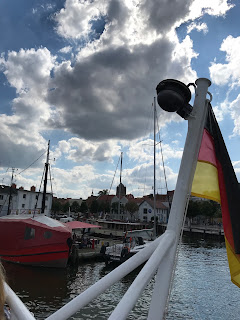

















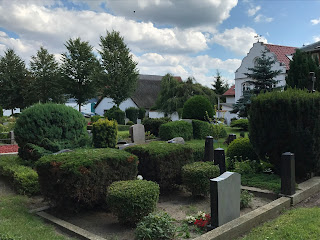


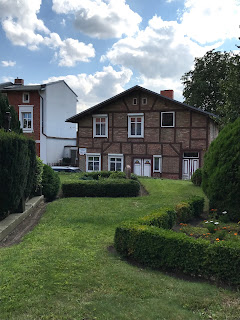






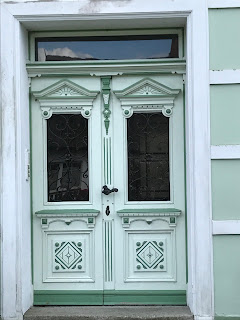
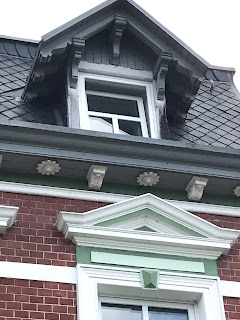







Keine Kommentare:
Kommentar veröffentlichen